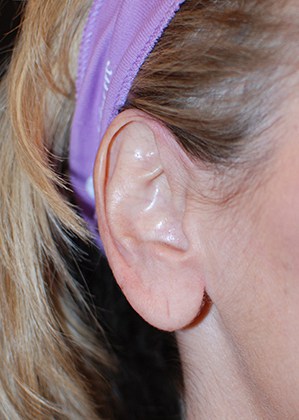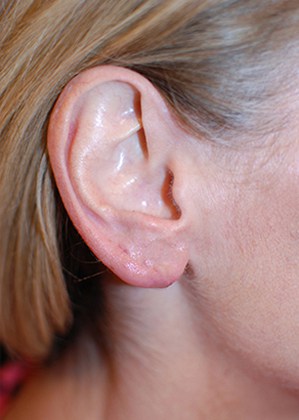Facial Plastic Surgery in Greenwich, CT Otoplasty / Earlobe Repair in Greenwich, CT
Conveniently located for Fairfield County & Westchester patients

Jump To:
At Elsa Raskin, MD, we offer otoplasty surgery, also called ear surgery, to improve the appearance of the ears in a number of ways. As part of otoplasty, we can also perform a variety of earlobe treatments, including minimally invasive dermal fillers for earlobes and earlobe repair surgery.
Earlobe repair surgery, also known as lobuloplasty, is a reconstructive plastic surgery procedure that is designed to restore the appearance of earlobes. Whether your earlobes have sagged or torn, earlobe rejuvenation is the perfect solution to restore their shape and aesthetic appearance.
Elsa Raskin, M.D., in Greenwich, CT is a skilled facial plastic surgeon who offers a number of
face procedures. She regularly performs otoplasty surgery to help patients feel content with the look of their ears.
The anatomy of the ear
The external ear, also called the auricle or pinna, is composed of skin, fat, and cartilage. The rim and the earlobe are two areas that are commonly adjusted during otoplasty surgery.
The rim (helix) is the mostly cartilaginous upper and outer part of the ear. In many cases, congenital malformations can affect the appearance of the rim of the ear. These manifest in the form of folded or missing cartilage.
The earlobe (lobule) is the fleshy lower part of the ear that is often pierced once or multiple times. The skin of the earlobe is extremely delicate, and the area is made up purely of fat and skin, meaning that it is malleable, soft and prone to sagging and splitting if reasonable or prolonged pressure is applied.
* Individual results may vary.
Photo Gallery
View before-and-after pictures of real patients of Dr. Elsa Raskin
View Before & Afters
When is otoplasty surgery necessary?
Otoplasty is necessary to correct issues that occur as a result of trauma or are congenital (are present at birth). This surgical procedure can be used to resolve macrotia (prominent ears), microtia (underdeveloped ears), cauliflower ear, lop ear, Stahl’s ear, and more.
Though otoplasty is typically not required for health reasons, ear malformations can often lead to teasing and deep self-esteem issues. With ear surgery, patients can enjoy a better quality of life as a result of having ears that fit with the rest of their facial features.
When does an earlobe repair become necessary?
An earlobe repair may be necessary or desired for a variety of reasons.
Some patients who choose to wear heavy earrings for long periods of time, find that the weight of their jewelry gradually stretches the piercing hole through the lobe until it splits into two.
Accidents and injuries involving earrings being ripped through the ear are also common, and result in the need for earlobe repair surgery.
Plug earrings have become a popular fashion accessory in recent years. This style of earring stretches the piercing hole much wider than normal. While it appears quite normal while the earring is in place, when it is removed there is nothing to support the elongated and stretched skin that then sags and looks unappealing.
Piercing holes that have been stretched using this method rarely heal, and so patients who have opted for this type of body expression often find their ears permanently altered.
Am I a suitable candidate for ear surgery?
Before you are given approval for your surgery, you will need to attend a consultation appointment with Dr. Raskin, where she will assess your ears to ensure you are a good candidate for ear correction with either surgery or fillers.
Most patients are good candidates for otoplasty, but certain situations will require delaying the procedure. Trauma-related ear issues should generally be given time to heal before otoplasty surgery is performed.
For children, it is best to wait until age four or five, when the ears have fully developed. This is because growth-related changes can affect the procedure’s results.
Otoplasty surgery preparation
For surgical ear correction, patients are required to stop smoking several weeks in advance of the procedure date. This will encourage effective tissue healing after the surgery and will decrease the chance of post-procedure complications.
Additionally, it will be necessary to avoid non-steroidal anti-inflammatory drugs (NSAIDs) before and after otoplasty. NSAIDs limit clotting ability, thus increasing the chance of excessive bleeding.
What does otoplasty surgery involve?
Otoplasty surgery is usually always performed as an outpatient, meaning that you will be able to walk in to have the procedure and walk out again once it is complete.
The surgery itself is performed under a local anesthetic and takes around an hour. For children, general anesthesia may be an option. Before your operation, Dr. Raskin will have worked with you to plan and design how to repair your ear so that it looks natural and aesthetically pleasing.
The procedure will vary depending on the type of correction being performed. If incisions are required, they will be made in locations that camouflage any post-surgical marks. Skin and cartilage will be reshaped and/or removed as needed.
If you have earlobes that are split or torn, they will be brought back together and secured using sutures. Earlobes that are elongated or stretched can be normalized by cutting away a small amount of skin and securing the lobe back together.
Earlobe rejuvenation with dermal fillers
For patients that are self-conscious of saggy or wrinkled earlobes, earlobe repairs with fillers are the easiest solution. Depending on your unique needs we might recommend, Juvederm, Restylane, Belotero, Radiesse, or Sculptra to give you firmer, younger looking earlobes.
Dermal fillers are injected into the earlobe with a small needle to add volume to the earlobe, firm creases and wrinkles, and reduce damage from large piercings. Filler injections are fairly painless treatments with minimal recovery time with the exception of some redness and swelling for 2-5 days after the injection.
Your earlobe rejuvenation treatment with fillers will last for up to a year, and in most cases, you can resume wearing earrings a few days after your treatment. Dermal filler treatments tend to last longer in your earlobes, since there is not any muscle movement in the cartilage of your earlobes, unlike other parts of the face.
How long will it take for my ears to heal after otoplasty?
The recovery process for
ear surgery is relatively short. You will be able to return home immediately after the procedure, with a dressing covering your ears.
The dressing can be removed after a time, and Dr. Raskin will give you specific aftercare advice to follow, which may include cleaning the wound with saline twice a day. You should follow these instructions in their entirety to minimize any side effects and get the best possible outcome from your surgery.
It will be important to keep your head elevated at all times during recovery, even overnight. You may need to use pillows to help with this. Wearing button-up shirts that you do not need to pull over your head will aid in the healing process, as will wearing proper sunscreen to protect the healing tissues of the ears.
Approximately two weeks after your ear procedure, you will return to Dr. Raskin to have your sutures removed. However, it may take up to six months for your ears to fully heal.
Will I be able to have my ears re-pierced again after the surgery?
An earlobe repair is designed to restore strength as well as appearance, and so once your ears are 100% healed, it will be possible for you to have your ears pierced again.
Otoplasty Cost
Your otoplasty cost may be reduced based on your healthcare coverage. Overall, ear surgery cost depends on the techniques required, the amount of time the procedure takes, the types of problems being resolved, and the type of anesthesia used. Typically the cost is $1,000.
Restore Your Ears with Otoplasty at Elsa Raskin, MD
If you would like to give your ears a more natural shape, otoplasty surgery may be the solution you are looking for. To find out more about this ear procedure, or to arrange a
consultation to assess your candidacy, make an appointment with
Dr. Elsa Raskin today by calling 203-861-6620.





